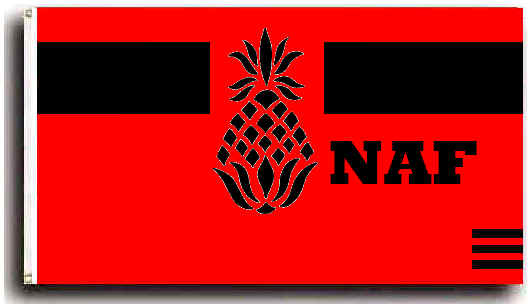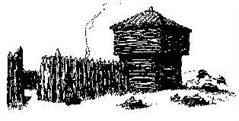|
.....
|
|

ELMER
DOOLITTLE
Staff
Writer |
Smoke Signals
Jul./Aug. '10
|
The other month I found this and forwarded it to
Buck, a little history of a place remotely
inhabited. Yet in the 17th and 18th centuries was on the
preferred maritime route to the Cape of Good Hope and the Indian
Ocean. We all like to put ourselves in a past life with this
hobby; just how serious are you, here's you chance folks to
really be primitive. Read on....
___________________________
We live in
a technologically advanced and interconnected world. Places that
were once almost impossible to reach are now accessible by road
systems, waterways and airplane
rides. Despite the ease with which we can contact people on the
other side of the globe -- whether it be through the click of a
mouse or a letter in the post -- about 10 percent of the Earth
is more than 48 hours away, by way of land travel, from the
nearest city [source: O'Neill].
While in recent years it definitely has become easier to reach
far away lands, there are many places in the world that remain
inaccessible, uninhabited and secluded -- in other words, the
most remote spots on Earth.
To
determine whether a location qualifies as "remote,"
you should consider the inaccessibility of the place (how
difficult it is to reach the spot) and its isolation (the
distance from the nearest inhabited location). In terms of
inaccessibility, the point farthest from sea is the Eurasian
Pole of Inaccessibility, which is located more than 1,553 miles
(2,500 kilometers) from any ocean and is located in northern
China. The point farthest from land is Point Nemo, which is in
the South Pacific, more than 1,553 miles (2,500 kilometers) from
any land mass [source: Murrell].
Neither of these locations are inhabited by humans.
What's the
most remote inhabited location on Earth? A place called Tristan
da Cunha. The approximately 270 residents of this archipelago
see a mail ship only once a year [source: Weaver].
Tristan da Cunha is located at 37 South and 12 West, 1,242 miles
(2,000 kilometers) from St. Helena and 1,739.8 miles (2,800
kilometers) from the nearest mainland, the Cape of Good Hope,
South Africa. Tristan is circular in shape and is about 6.2
miles (10 kilometers) in diameter with a total area of only
about 30 square miles (78 square kilometers). The summer season
falls between December and March. During the winter months, the
central volcanic peak of Tristan, which rises to a height of
6,594 feet (2,010 meters), is covered in snow. Tristan da Cunha,
the main island, is the only inhabited island in the chain. The
other islands that make up the archipelago -- Nightingale,
Stoltenhof, Gough, Middle and the appropriately named
Inaccessible -- are not populated
by humans.
But how did people come to
inhabit this remote island chain? And how did they find out
about it in the first place? Find out on the next page.
Today, Tristan da Cunha is
certainly off the beaten path and is considered the most remote
inhabited island on the planet. But in the 17th and 18th
centuries, the archipelago was on the preferred maritime route
to the Cape of Good Hope and the Indian Ocean. The islands of
Tristan da Cunha were discovered by Portuguese explorer Tristao
da Cunha during an expedition to the Cape of Good Hope in 1506.
In 1643, the first recorded crew, the Dutch Heemstede, landed on
Tristan to replenish supplies. In 1650 and 1669, the Dutch
initiated efforts to explore the island as a base but soon
abandoned the idea, perhaps because Tristan lacked a safe
harbor.
Several
Americans attempted to make use of Tristan in the 18th and 19th
centuries. In 1790, Captain John Patten of Philadelphia used the
island as a sealing and whaling
base. In 1810, Jonathan Lambert of Salem, Mass., attempted to
establish a trading station there. During the War of 1812,
American forces used Tristan as a base to defend against British
attacks.
While
today's Tristan is off the international political radar,
it was at the center of the strategic military scene during the
early 1800s. On Aug. 14, 1816, the British military took
possession of the island to prevent the French from using
Tristan to rescue the deposed emperor Napoleon who was
imprisoned on St. Helena, about 1,242 miles (2,000 kilometers)
away. The British also aimed to keep Americans from using
Tristan as a base again.
Despite
this initial political interest in Tristan, the British military
soon lost interest in its strategic importance and began to
gradually abandon the island in 1817. With the opening of the
Suez Canal in 1869, routes through the South Atlantic were no
longer necessary for trans-Atlantic trade, and ships ceased to
pass through Tristan. However, some of Tristan's original
residents stayed on the island, and, in addition to a few
shipwreck survivors, they continued to populate
the island. Many of their descendants still live on this remote
island in the middle of the South Atlantic.
Today,
Tristan is classified as a United Kingdom Overseas Territory,
and all of its residents are British citizens. The residents of
Tristan da Cunha, who live in the settlement of Edinburgh, share
just eight surnames [source: Weaver].
Tristan houses a school, hospital, post office, museum, cafe,
pub, craft shop, village hall and swimming pool. The island is
financially self-supporting, and residents earn most of their
income from fishing and, oddly, the sale of postage stamps. An
optician and dentist are sent from the United Kingdom once a
year. While there's no airport on Tristan, cruise ships
occasionally visit the island, and crawfish trawlers from Cape
Town come to the island about six times per year [source: The
Commonwealth].
___________________________
This is pretty good food for
thought, hope you enjoyed a little off the beaten track.
Later
Elmer D...
 
___________________________
|